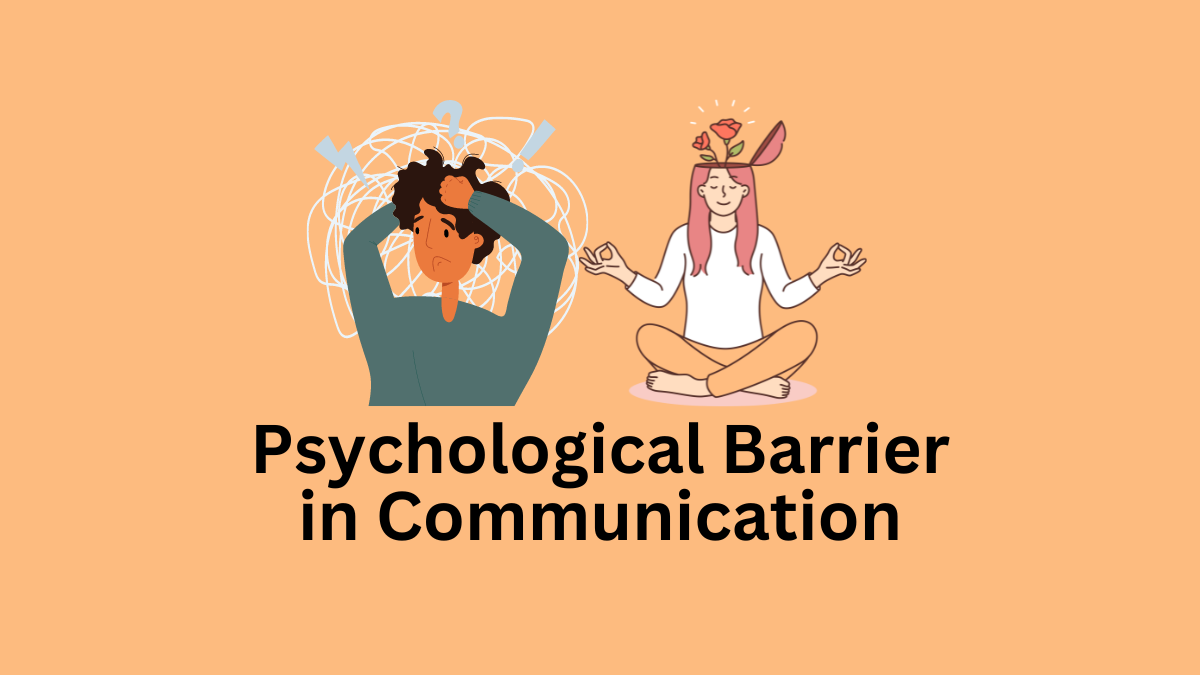What is Psychological Barrier in Communication?
Psychological barriers in communication refer to internal obstacles rooted in human perception, attitudes, and behaviors that impede the effective exchange of information.
These barriers include distrust of superiors’ messages, superiority complexes among managers, perceptual differences among individuals, premature evaluation of communication content, and lack of attention due to personal tension or workload.
Such barriers inhibit the smooth flow of information, hinder understanding, and create conflicts, ultimately hampering organizational productivity and goal achievement. Addressing these barriers involves fostering trust, promoting open communication channels, encouraging active listening, and providing opportunities for clarification and feedback.
By recognizing and overcoming psychological barriers, workplaces can cultivate a culture of transparent communication, mutual respect, and collaboration, leading to improved performance and success.
Causes of Psychological Barriers to Communication
Below are eight causes of psychological barriers to communication in the workplace:
Distrust of Communicator
Subordinates may distrust messages from superiors, fearing they may be altered or misrepresented. Even genuine communication from higher-ups may not be taken seriously due to this lack of trust.
Superiority Complex
Managers or higher authorities with a superiority complex may feel above communicating with subordinates, hindering the free flow of information. This attitude can create a hierarchical divide and inhibit open dialogue.
Individual Perception
Different individuals perceive events and information differently, leading to misunderstandings and conflicts. Varied interpretations of messages can arise due to differences in personal experiences, biases, and cultural backgrounds.
Premature Evaluation
Subordinates may prematurely evaluate communication content before fully understanding it, leading to misunderstandings and conflicts with superiors. This tendency to judge without complete information can impede effective communication.
Lack of Attention
Personal tension or overwhelming workloads can cause individuals to neglect communication, hindering their ability to fully engage with the message. Inattention prevents the intended purpose of communication from being fulfilled, leading to missed opportunities and misunderstandings.
Read More: Physical Barrier in Communication
Emotional States
Emotional fluctuations such as stress, anxiety, or frustration can cloud judgment and affect communication effectiveness. Strong emotions can distort messages, leading to misinterpretations and breakdowns in communication.
Closed Mindset
Individuals with a closed mindset may be resistant to new ideas or perspectives, leading to communication barriers. Fixed opinions and unwillingness to consider alternative viewpoints can hinder constructive dialogue and problem-solving.
Lack of Feedback
The absence of timely and constructive feedback in the workplace can create barriers to communication. Without feedback, individuals may not know if their message was received as intended, leading to uncertainty and ambiguity.
Read More: 10 Objectives of Leadership in Business
Strategies To Overcome Psychological Barriers in Communication
Here are five strategies to overcome psychological barriers to communication in the workplace:
Foster Trust and Transparency
Building trust among team members and between hierarchical levels is crucial for effective communication. Encourage open and transparent communication channels where individuals feel comfortable expressing their thoughts and concerns without fear of judgment or reprisal.
When trust is established, employees are more likely to believe and engage with the messages conveyed, reducing the impact of distrust as a psychological barrier. Transparency promotes clarity and ensures that information is disseminated accurately, minimizing misunderstandings and conflicts.
Promote Active Listening
Encourage active listening skills among employees by emphasizing the importance of attentive and empathetic listening during communication exchanges. Active listening involves fully concentrating on what is being said, understanding the message from the speaker’s perspective, and providing appropriate feedback.
By actively listening to others without interruptions or distractions, individuals can overcome perceptual differences and clarify misunderstandings. Active listening fosters mutual respect and understanding, leading to more meaningful and productive interactions in the workplace.
Encourage Empathy and Perspective-taking
Promote empathy and perspective-taking among team members to foster understanding and collaboration. Encourage individuals to consider the perspectives and feelings of others during communication exchanges, recognizing that different people may interpret information differently based on their experiences and backgrounds.
Read More: Leadership in Management
By empathizing with others’ viewpoints and acknowledging their feelings, employees can bridge perceptual differences and build stronger relationships. Empathy promotes inclusivity and fosters a supportive communication environment where everyone feels valued and heard.
Provide Training and Development
Offer training and development programs focused on enhancing communication skills and overcoming psychological barriers. Provide employees with tools and techniques for effective communication, including conflict resolution, active listening, and empathy-building exercises.
By equipping employees with the necessary skills and strategies to navigate communication challenges, organizations can empower individuals to communicate more confidently and collaboratively. Training programs also create opportunities for self-reflection and personal growth, enabling employees to identify and address their psychological barriers to communication.
Establish Clear Communication Norms
Establish clear communication norms and expectations within the organization to guide interactions and promote consistency. Define communication channels, protocols, and expectations for sharing information, providing feedback, and resolving conflicts.
By setting clear guidelines for communication, organizations can reduce ambiguity and uncertainty, ensuring that messages are conveyed effectively and understood correctly. Clear communication norms also promote accountability and accountability, creating a cohesive and communicative workplace culture where everyone feels empowered to express themselves openly and respectfully.
Read Next: Organizational Barrier in Communication

Sujan Chaudhary holds a Bachelor in Business Administration (BBA) degree and is currently pursuing an MBA degree. He loves to share his business knowledge with the rest of the world.
